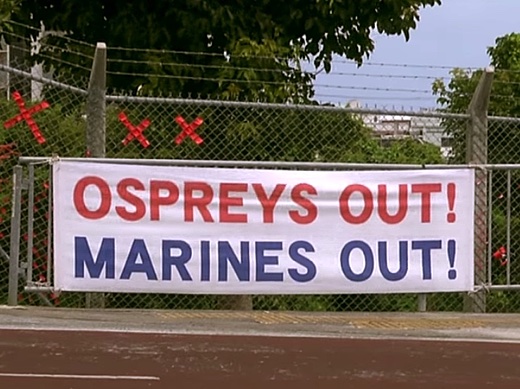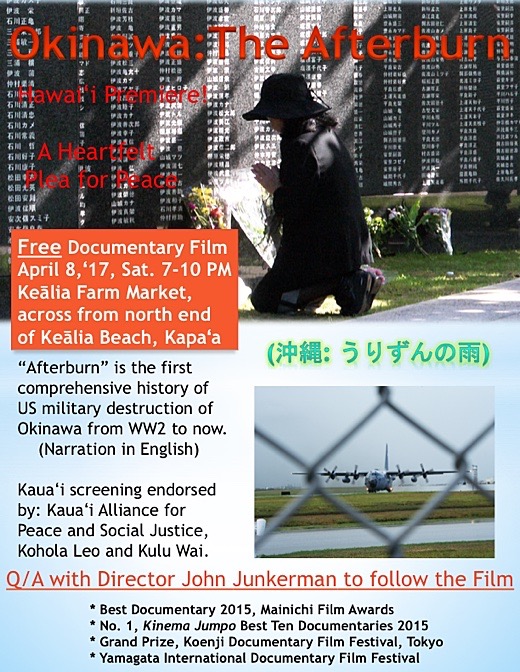SOURCE: Katherine Muzik PHD (kmuzik@gmail.com)
SUBHEAD: Okinawans stand out for the tenacity and, at times, ferocity of their opposition to US military.
By Juan Wilson on 18 March 2017 for Island Breath -
(http://islandbreath.blogspot.com/2017/03/see-film-okinawa-afterburn.html)

Image above: Still frame from movie trailer "The Okinawa: Afterburn" shows sign reading "Ospreys Out! Marines Out!" That's one reason we see the Marines' Ospreys on Kauai now.
If you don't smell the acrid smoke yet you should be better aware. Kauai is heading for something like the occupation the US military has visited on the Japanese island of Okinawa since the end of World War II.
There is a planned military build up here and it will have most effect the south and west side of our island.
The Federal Missile Defense Agency is looking to convert Navy's Aegis research base at PMRF into a permanent missile base.
The US Marine's unstable Osprey helicopter program is going to be using the Na Pali Coast as a "training" environment.
To top it off the US Air Force 86th Fighter Squadron has a five year plan to practice attacking the Pacific Ocean, and it denizens from the runways of the PMRF.
That's just for starters. With Trump facing off against the Chinese and North Koreans expect a lot worse to come soon.
For an idea of the impact on Kauai I advise you look at what the US military has done to Okinawa see "The Afterburn".

Image above: Poster foe showing of "The Okinawa: Afterburn" on Kauai.
SUBHEAD: Okinawans stand out for the tenacity and, at times, ferocity of their opposition to US military.
By Juan Wilson on 18 March 2017 for Island Breath -
(http://islandbreath.blogspot.com/2017/03/see-film-okinawa-afterburn.html)

Image above: Still frame from movie trailer "The Okinawa: Afterburn" shows sign reading "Ospreys Out! Marines Out!" That's one reason we see the Marines' Ospreys on Kauai now.
If you don't smell the acrid smoke yet you should be better aware. Kauai is heading for something like the occupation the US military has visited on the Japanese island of Okinawa since the end of World War II.
There is a planned military build up here and it will have most effect the south and west side of our island.
The Federal Missile Defense Agency is looking to convert Navy's Aegis research base at PMRF into a permanent missile base.
The US Marine's unstable Osprey helicopter program is going to be using the Na Pali Coast as a "training" environment.
To top it off the US Air Force 86th Fighter Squadron has a five year plan to practice attacking the Pacific Ocean, and it denizens from the runways of the PMRF.
That's just for starters. With Trump facing off against the Chinese and North Koreans expect a lot worse to come soon.
For an idea of the impact on Kauai I advise you look at what the US military has done to Okinawa see "The Afterburn".

Image above: Poster foe showing of "The Okinawa: Afterburn" on Kauai.
See movie "Okinawa: The Afterburn" about American military occupation of Okinwawa
Narration in English. Q/A with director John Junkerman to follow the film.
WHEN:
April 8th 2017 from 7:00pm to 10:00pm
WHERE:
Kealia Farm Market
Across the highway from the north end of Kealea Beach in Kapaa
"Afterburn" is the first comprehensive history of the United States military destruction of Okinawa from World War II to now. The Kauai screening is endorsed by the Kauai Alliance for Peace and Social Justice, Koloha Leo and Kulu Wai.
REVIEW:
John Junkerman documentary ‘Okinawa: The Afterburn’ sheds light on the ferocious anger against U.S. bases.
Video above: "Okinawa: The Afterburn" trailer. From (https://youtu.be/0D03LeeZe-U)
By Mark Schilling on 17 June 2015 for Japan Times -
(http://www.japantimes.co.jp/culture/2015/06/17/films/film-reviews/john-junkerman-documentary-okinawa-afterburn-sheds-light-ferocious-anger-u-s-bases/#.WM2Bk47atE4)
The issue of the large U.S. military presence in Okinawa is divisive, deeply rooted and, frankly, one I have never completely understood. Anti-base protests have been going on for decades, and while locals elsewhere in the developed world may have been unhappy with the bases in their vicinity, the Okinawans stand out for the tenacity and, at times, ferocity of their opposition. What keeps them going?
John Junkerman’s documentary “Okinawa: The Afterburn” (“Okinawa: Urizun no Ame”) sheds more light on this question than any of the other Okinawan-themed films I have seen, fiction or nonfiction.
As a former Okinawa resident who has lived in Japan for nearly four decades, Junkerman is unabashedly on the side of the protesters (in a program note he describes the Okinawan islands as “spoils of war”), but he presents both sides without strident editorializing.
He has also found archival footage and living witnesses to Okinawa’s troubled history, which illuminate — far more brightly than the standard journalistic regurgitation of facts and figures — why Okinawans continue to resist the bases 70 years after the Battle of Okinawa began on April 1, 1945.
The film begins with an account of that battle, accompanied by interviews with elderly but articulate survivors — Japanese, Okinawans and Americans.
One survivor of the battle is former Okinawa governor and anti-base activist Masahide Ota. “A lot people here say that battle still continues. That has certainly been true for me,” he says.
Another is Masa Inafuku, who served as a 17-year-old student nurse at the height of fighting. “There was no place in the world where the fighting was so futile,” she says.
Still another is Kamado Chibana, who was 26 when 83 civilians hiding in a cave with her committed group suicide rather than surrender to the Americans, despite assurances from Japanese-fluent soldiers that they wouldn’t be harmed.
These and other testimonies are illustrated by rarely seen color footage of the battle and its aftermath, showing soldiers with what former sergeant Leonard Lazarick describes as “thousand-yard stares,” as well as emaciated Okinawan civilians on the brink of collapse.
The film follows the story of these survivors and the succeeding generations, as Okinawa became a key launch pad for U.S. wars in Asia and the Middle East.
In the 1960s, local activists campaigned for the reversion of Okinawa to Japan from the U.S., who were then ruling the island as a military protectorate. “Japan didn’t fight wars, had no nuclear weapons and its economy was booming,” explains Eiko Asato, a writer who was a teenage activist at the time.
After Okinawa was returned to Japan in 1972, however, locals soon realized that the bases would remain, with the ruling Liberal Democratic Party’s support, together with all the problems that had long accompanied them.
The film focuses on sexual violence perpetrated by U.S. soldiers on Okinawan women and others in the military, male and female. Witnesses from both sides testify, including a former soldier involved in a highly publicized 1995 group rape of a 12-year-old Okinawan girl.
The film concludes with an overview of ongoing disputes, including the protests over the construction of a new U.S. base in Nago’s Henoko district, which — after the intense opening sections — feels slightly scattershot. But it’s hard to neatly tie up the 70-year history of the U.S. military on the island with a bow, as the struggle continues.
Despite its English subtitle, “Afterburn” — a reference to Okinawa’s long postwar trauma — the film does not view the struggle as never-ending. The Japanese title, “Urizun no Ame,” means “the rains that herald spring” — the season of hope.
See also:
Ea O Ka Aina: USMC contaminates Okinawa bases 2/20/17
Ea O Ka Aina: Japan's Anger is Past its Limit 6/21/16
Island Breath: Militarism in Hawaii 4/29/04
For a special look into the mindset of US Marines in Okinawa check out "It's Universal"
Ea O Ka Aina: It's Universal 1/1/09
How the US Marines behave in Okinawa illustrate how crazy we are.
.
No comments :
Post a Comment